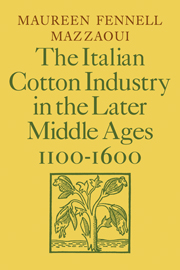Book contents
- Frontmatter
- Contents
- List of illustrations
- Preface
- List of abbreviations
- Map
- Introduction
- PART ONE THE ROLE OF COTTON IN THE MEDITERRANEAN ECONOMY
- 1 Cotton cultivation in the ancient and medieval world
- 2 The Mediterranean cotton trade 1100–1600
- PART TWO THE ORGANIZATION OF THE NORTH-ITALIAN INDUSTRY
- PART THREE THE GROWTH OF COTTON MANUFACTURE NORTH OF THE ALPS
- APPENDICES
- Notes
- Select bibliography
- Index
1 - Cotton cultivation in the ancient and medieval world
Published online by Cambridge University Press: 05 March 2012
- Frontmatter
- Contents
- List of illustrations
- Preface
- List of abbreviations
- Map
- Introduction
- PART ONE THE ROLE OF COTTON IN THE MEDITERRANEAN ECONOMY
- 1 Cotton cultivation in the ancient and medieval world
- 2 The Mediterranean cotton trade 1100–1600
- PART TWO THE ORGANIZATION OF THE NORTH-ITALIAN INDUSTRY
- PART THREE THE GROWTH OF COTTON MANUFACTURE NORTH OF THE ALPS
- APPENDICES
- Notes
- Select bibliography
- Index
Summary
One striking aspect of the rise of the north-Italian cotton industry in the twelfth century was its total dependence for raw materials on areas of supply where cotton cultivation had been either recently introduced or had undergone a dramatic expansion in the previous three hundred years. Changes in patterns of cultivation in the zones of European commercial and political penetration along the shores of the Mediterranean and the Black Sea were part of a broader agricultural boom in both foodstuffs and industrial crops in Asia and the Islamic world between 800 and 1100 A.D. The geographical spread of the cotton plant was linked in a cause and effect relationship to the intensification of textile production in Eastern manufacturing centers. Through increased output and lower costs, cotton was transformed from a luxury commodity for an elite into an article of popular consumption. It continued to play the same role in the developing economy of western Europe where the success of the medieval Italian industry was based on production for mass markets.
The importance of this agricultural and industrial transformation has often been overlooked owing in part to the subsequent disappearance of the crop from many of the original zones of production. The present chapter attempts to reconstruct the geographical radius of the cotton plant and the distribution of textile manufacturing centers in the ancient and medieval world, with particular attention to those areas which constituted the main sources of supply for the early European industry.
- Type
- Chapter
- Information
- Publisher: Cambridge University PressPrint publication year: 1981



